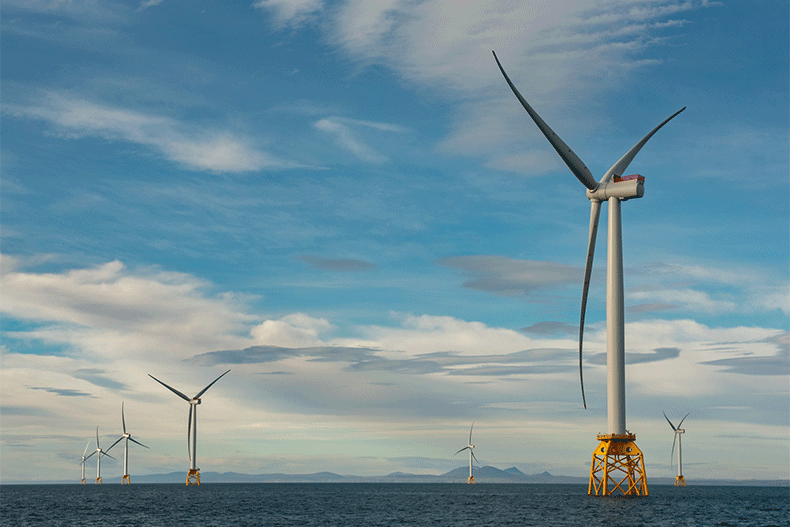SSE Renewables to Apply for Marine Area Consent for Arklow Bank Project

SSE Renewables has confirms its intention to apply for a Maritime Area Consent (MAC) for its Arklow Bank Wind Park Phase 2 project under the new consenting regime announced earlier this week by Minister for the Environment, Climate and Communications, Eamon Ryan TD.
The decision by SSE Renewables to transfer Phase 2 of Arklow Bank Wind Park from the current route of delivery via the Foreshore Act into the MAC regime has been notified to both the Minister for Environment, Climate and Communications and to the Minister for Planning.
The company’s offshore wind energy project will now progress through the MAC regime alongside other qualified Offshore Renewable Energy (ORE) projects in the Irish Sea and off the west coast of the island.
SSE Renewables had been actively engaged in developing Arklow Bank Wind Park early, via the Foreshore Act. With the introduction by Government of the Maritime Area Planning (MAP) Act in December 2021, SSE Renewables will now progress the project via the newly introduced marine planning process. Although proceeding via the MAP process will mean delivery of the project will be later than the timescale initially envisaged under the Foreshore Act, it will unlock a substantial increase in capacity at the site.
Transferring Arklow Bank Wind Park Phase 2 to the MAP process allows SSE Renewables to revise the project and substantially increase the power generation output from the site to 800MW. This means the project will be able to make an even more significant contribution to Ireland’s climate action target of at least 5GW by 2030, and to Ireland’s national and local economy.
The revised project will now be capable of powering almost 850,000 homes each year, almost double the number of homes targeted by the initial iteration of the project, and offsetting around 830 billion kilos of harmful carbon emissions annually.
The upscaled offshore wind energy project is expected to require an investment of up to €2.5 billion and, under current planning timelines, is expected to deliver in 2028, subject to a final investment decision.
The project’s operations and maintenance base will continue to be located at Arklow Harbour’s South Dock, where 80 people will be employed to support the wind farm over its operational lifetime. Furthermore, the proposed onshore underground cable route and the location of the substation at the Avoca River Business Park remain unchanged.
Once operational the wind farm will also deliver a multi-million-euro annual community fund which will now grow in line with the increased level of MWs generated.
"SSE Renewables is totally committed to Arklow, to County Wicklow and north Wexford, and to the Arklow Bank Wind Park project. We expect to be able to invest around €2.5 billion in the revised project to deliver a new 800MW offshore wind farm by 2028 which will produce substantially greater power generation output at Arklow Bank than under our previous plans.
BARRY KILCLINEDIRECTOR OF OFFSHORE DEVELOPMENT IRELAND AT SSE RENEWABLES
As a result, the project will make an even more significant contribution to Ireland’s climate action targets and our economy, both nationally as well as locally. The increased offshore energy output will also greatly enhance the annual value of the community fund investment that we can deliver to communities in south Wicklow and north Wexford."
Under the new process SSE Renewables will be required to prepare a new Environmental Impact Assessment for the wind park’s offshore infrastructure. The company intends to commence a draft of this report later this year as part of the project’s ongoing development.
About the Maritime Area Planning (MAP) Act
In December 2021, the Maritime Area Planning (MAP) Act was introduced by the Government to regulate Ireland’s maritime area for various uses including offshore wind energy development. Under Ireland’s new offshore consenting process, developers must have a Maritime Area Consent to make an application for permission, to include environmental assessments, to An Bord Pleanála.
MAC applicants will be assessed in key areas, including financial and technical competency. The assessments will be made by the Minister for Environment, Climate and Communications and the first MACs are expected to be issued in the second half of 2022. This will enable the first Offshore Renewable Energy Support Scheme (ORESS) to open in Q4 2022.
834,000 homes powered based on projected installed capacity, typical projected offshore wind load factor of 50%, and typical annual consumption (4,200kWh). Quoted 830 billion kilos of carbon emissions abated based on projected annual MWh output and latest average CO2 Emissions (0.236g/kWh) in the All-Island Single Electricity Market, and published by the CRU in its Fuel Mix Disclosure and CO2 Emissions for 2020, October 2021.
